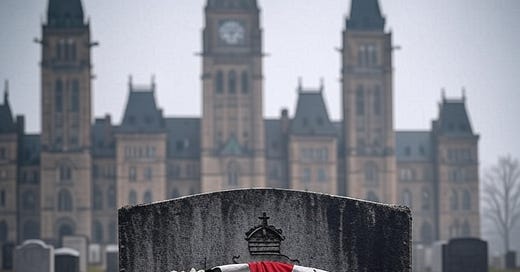For those who prefer to listen to the article, the author has also recorded an audio version.
It is with great hubris that Canadians deny the passing of our once lauded nation. Today, on Canada’s 45th general election, we will head to the polls to cast our ballots. Many are optimistic their vote will be the heart transplant our terminal country needs. Sadly, no ballot will resurrect what misplaced pride and civic neglect have already buried. For too long, we have left our nation to its reputation earned by generations long past. We attributed laurels of bygone great leaders to all who asked to lead the last 50 years. We chose willful ignorance over righteous indignation election after election. Successive politicians legislated one deep wound after another into the heart of our nation. Yet, with only two-thirds of us voting in our elections, we offered mere transfusions of different political blood when those wounds bled out. Citizens never demanded the injuries be treated; no government cauterized the bleeds. Regardless of this election’s outcome, we have already failed to “Stand on Guard for Thee.” The Canada of yesteryear will stay there; the Canada of tomorrow—already unrecognizable—sings no anthem worth hearing.
In denying Canada’s passing, we cling to the glories that once defined us. Our history offers no shortage of defining moments. Though technically British subjects, soldiers from Canada ignited the flame of national pride when they took Vimy Ridge in April 1917. Four all-Canadian divisions, totaling almost 100,000 men under the command of Canadian-born General Arthur Currie, captured the ridge that both British and French forces failed to seize after months of assaults. Though casualties were heavy, Vimy Ridge birthed the global reputation we think still exists today. The “War to end all wars” did not, and World War II’s horrors tested that resolve further. From Dieppe to Juno Beach to freeing the Dutch, our nation defined itself, fierce, united, and enduring—a legacy we’d soon squander.
Our then-defined great nation of courage, grit, and steeled determination became an international conciliator and reputed peacekeeper. From Banting and Best’s 1921 discovery of insulin—the reason I live and write today—to Lester B. Pearson’s diplomacy during the 1956 Suez Canal Crisis, we stood tall. From the Trans-Canada Railway, uniting East and West as neighbors in 1885, to the Maple Leaf flag in 1965 and Expo 67’s global dazzle, Canada’s first 100 years were its best. The last 50 years: a death march of neglect, relegating these sacrifices and accomplishments to historical footnotes barely remembered today.
It may take an autopsy by forensic historians to pinpoint Canada’s death blow. With hindsight, we can see our nation’s ill health emerged in the 1960s with the Front de Libération du Québec (FLQ). The violent separatist movement, starting in 1963, progressed from throwing Molotov cocktails at military barracks to bombing the Montreal Stock Exchange to kidnapping and murdering Quebec’s Deputy Premier. The nation that stormed the beaches of Normandy could not pacify—nor reconcile—domestic dissent. In October 1970, Prime Minister (PM) Trudeau Sr. imposed martial law on Canadian citizens, enacting the heavy-handed War Measures Act. The October Crisis slashed the first of many deep wounds into Canada’s democracy and its unity as a nation.
That wound festered into a decade of rot. Neither the murder of a Minister of the Crown nor the FLQ’s death quelled Quebec’s separatist mood. René Lévesque and the Parti Québécois seized the baton. The 1970s bore witness to Quebec’s “Quiet Revolution” of identity. By 1977, Bill 101—the Charter of the French Language—made Quebec a distinct nation within the nation. Quebec beat the country to a Charter, leaving chicken politicians flailing. Canada started losing feathers as Anglophones fled Quebec and unity frayed. By 1980, the country was bleeding out. Quebec’s spring referendum and Trudeau Sr.’s National Energy Program in the fall sparked another decade of decline. With Quebec smouldering over sovereignty and the oil-rich West incensed, the geographic links joining East and West were tensioned to snap.
There was to be only superficial relief to Canada’s ailments. Trudeau Sr.’s 1982 swan song, the Charter of Rights and Freedoms, was an organ transplant from a faulty donor—rotten before it took. We took pride in patriation, swapping an old-world crown for a shiny, flawed Canadian one. At 115 years old, Canada was finally an adult, or so it thought. In 1983, the country was battling 7% inflation, 11% interest rates, and 12% unemployment. The 1981 “Night of Long Knives” cuts had left Quebec crying foul and refusing to sign the Canadian Charter. The new Canadian Crown had poorly fused bands and one very loosely set jewel.
In 1985, the tarnish began. An Air India bombing killed 329, 268 of them Canadian. This was not a foreign terrorist attack, but orchestrated in Canada, by a Canadian, against Canadians in the name of a Khalistani Sikh conflict in India. The nation avoided sepsis but started bleeding out again, spilling the blood of its own innocent citizens. The 1984 CSIS Act giving birth to the intelligence agency did nothing to stop this; foreign hands were digging in. Partisan politics started to take control of MPs and institutions. Canadians’ blind faith in leaders of the day—assuming their laurels matched the heroes of old—fostered a wilful ignorance and unearned pride that took root in the nation.
To dress the wounds, the government touted the 1988 Emergencies Act as proof all was well—the government, Canada’s hero of the day. The 1990 collapse of the Meech Lake Accord exposed Quebec’s distinct society as dangerously divisive. The 78-day Oka standoff reignited Indigenous territory disputes. The 1990s began with the country hemorrhaging from within—foreign actors settling in, nations gaining momentum within the nation. Politicians consumed by partisanship and romanced by power ignored the fractures, while voters smugly picked between red and blue teams. Canada began its arduous crawl toward intensive care.
The Charlottetown Accord in 1992 failed to settle Quebec’s refusal to sign the Canadian Charter. In 1995, the nation nearly shattered when 49.4% of Quebecers voted to separate—a difference of 32,000 votes among the 4.75 million cast saved Canada from instant death. It was as close a call as a nation can get to critical condition—nearly losing 15% of its landmass and 24% of its population. Not close enough to prompt us or our politicians to seriously address any of the injuries. Economic conditions were improving across the nation, insulating us from the country’s poor health as the world braced for Y2K. The clocks rolled over; the world’s computer infrastructure was not wiped out; the memory of Canada’s sepsis was forgotten.
The 21st century started under great distraction with the September 11, 2001, terrorist attacks in New York. Our neighbour, the world’s superpower, had a score to settle. Canada’s military suited up; the nation stood by. The 2004 Sponsorship Scandal, followed by the 2005 Gomery Report, uncovered a $100-million scam of tax dollars funneled to Liberal insiders—systemic corruption laid bare—the nation’s gangrene exposed for all to see. None jailed; no funds recovered. We chose blue to punish red—the disease progressed. Blue team stewarded the country for a decade, seeing it through the 2008 global financial crisis with made-in-Canada solutions. And it left Canada with the Federal Accountability Act, touted as “the toughest anti-corruption law ever.” In 2015, we switched teams as Canada approached 150 years old. The mood was good. Citizens were ready to celebrate. Nobody checked on the patient. Everyone forgot it was unwell, save maybe the son of the PM who took that first deep cut in 1970.
The decade steered by PM Trudeau Jr. will likely be where historians find the fatal blow. His post-national vision of a country without core identity progressed easily, perhaps because Canada was already near death. The prior government’s “toughest anti-corruption law” proved weaker than the death rasps of our once-great nation. Year after year the government—judged in today’s election—amassed more corruption scandals and debt than all prior governments combined. It flooded the country with low-skilled, at-risk populations, importing foreign conflicts. Foreign interference became a household term.
In 2020, COVID-19 prompted arbitrary rules shutting down businesses and lives, mandating medical treatment. The 2022 Freedom Convoy, celebrated globally for peaceful civil disobedience against government overreach, was maligned by our government and media. On Valentine’s Day 2022, the government unleashed its might against citizens again, invoking the Emergencies Act. In 1970, Trudeau Sr. invoked its predecessor after eight years of violent unrest in Quebec, only after a minister’s kidnapping and murder. In 2022, Trudeau Jr. used the 1988 Charter-respecting version to crush a three-week trucker protest in Ottawa—noisy, charitable, unifying, yet wounding only the PM’s pride.
That 1970 crisis slashed Canada’s first deep wound, turning on its own citizens. Fifty-two years later, Trudeau Jr.’s wounded pride tore it apart. The Canada of 2025 is government vs citizens. It’s also become Hamas vs Israel, Ukraine vs Russia, Khalistan vs India, even Canada vs the U.S.A. It’s not a shadow of its former self—it’s unrecognizable, steeped in conflict and arrogance. In 2022, the most Canadian protest this country ever witnessed was illegally crushed by an out-of-control minority government. In 2025, hate rallies calling for death and war abroad and at home are left unchecked, further shredding our once-great nation’s fabric. The Canada of today will persist tomorrow, despite the votes counted, never again to be the Canada of yesteryear. That is to be mourned today.
Canada shone brightly its first 100 years. The boomer generation was the last to bask in its glory, each generation since inheriting a fading legacy. Our forefathers sacrificed for global peace and stability. But our citizens and leaders neglected its care at home. Over the last 50 years, Canada fell from punching above its weight to hitting below the belt. The past decade saw us turn inward, overrun by cultures and ideas that clash with Canadian values we stopped defending. We adopted climate and gender ideologies that weakened our core. Once a bastion of anti-racism, Canada now accuses itself of systemic racism, discrimination, and even genocide. With old wounds left to rot, we ignored the life draining from our nation until its heart stopped. Canada’s death went unnoticed, without fanfare or even a moment’s silence. Take that silence today, before you cast your ballot. Your vote will not resurrect the Canada already buried.
Chris Nerpin is an Independent Accounting Professional working in the Nation's capital. A politics junkie, he's watched, played, and written about politics since junior high. Never a shy observer, he doesn't hesitate to call things as he sees them. You can find more of his opinions about Canadian politics and social issues on X @chrisnerpin.







Sad. But on the other hand, about the same can be said about any formerly proud Western nation - all being destroyed from within by their very own "democratically elected" victims of arrested development. Quite a short run of worldwide "democracy", aka "the best system of government ever", with quite a uniform result. Next time - if there is a next time - people should probably consider concentrating more on WHO governs them than on the slapstick process of HOW they get there.
Thank you Chris. Canada is at a major cross road and the outcome is not year clear. Will the Liberals and Conservatives finally act like adults and put all Canadians and our amazing natural resources first?